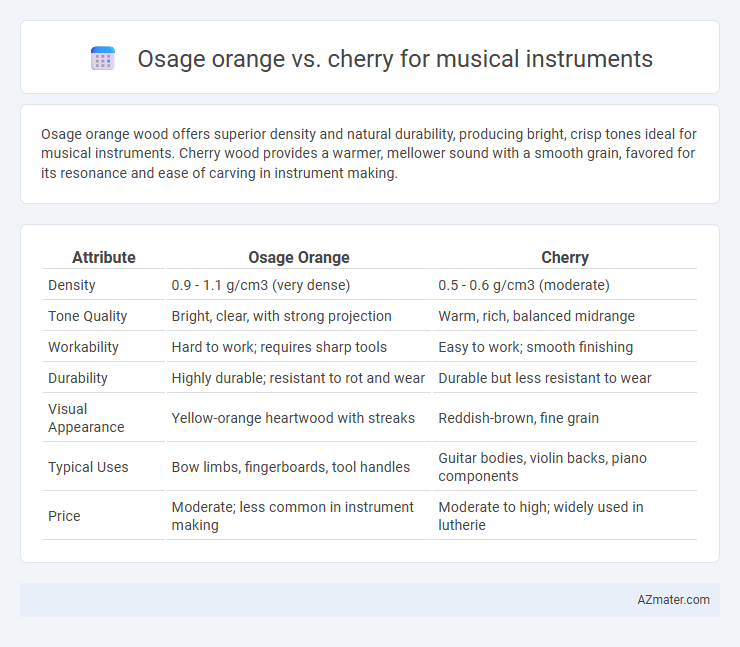Osage orange wood offers superior density and natural durability, producing bright, crisp tones ideal for musical instruments. Cherry wood provides a warmer, mellower sound with a smooth grain, favored for its resonance and ease of carving in instrument making.
Table of Comparison
| Attribute | Osage Orange | Cherry |
|---|---|---|
| Density | 0.9 - 1.1 g/cm3 (very dense) | 0.5 - 0.6 g/cm3 (moderate) |
| Tone Quality | Bright, clear, with strong projection | Warm, rich, balanced midrange |
| Workability | Hard to work; requires sharp tools | Easy to work; smooth finishing |
| Durability | Highly durable; resistant to rot and wear | Durable but less resistant to wear |
| Visual Appearance | Yellow-orange heartwood with streaks | Reddish-brown, fine grain |
| Typical Uses | Bow limbs, fingerboards, tool handles | Guitar bodies, violin backs, piano components |
| Price | Moderate; less common in instrument making | Moderate to high; widely used in lutherie |
Introduction to Osage Orange and Cherry Woods
Osage orange wood, prized for its exceptional density and bright orange hue, offers superior durability and tonal clarity, making it a unique choice for musical instruments. Cherry wood, known for its warm reddish-brown color and fine grain, yields a rich, balanced sound with appealing resonance and ease of workability. Both woods provide distinct acoustic qualities, with Osage orange emphasizing brightness and sustain, while cherry favors warmth and smooth midtones.
Physical Properties: Osage Orange vs Cherry
Osage Orange exhibits exceptional density and hardness with a Janka hardness rating around 2,200 lbf, making it highly durable and resistant to wear for musical instrument components like bridges and fingerboards. Cherry wood, with a moderate Janka hardness of approximately 950 lbf, offers greater workability and a smooth finish, favored for soundboards and necks due to its balanced stiffness and resonance. The higher density of Osage Orange contributes to brighter tonal qualities and increased sustain, whereas Cherry provides warmer, more mellow sound characteristics with enhanced tonal clarity.
Tonal Qualities and Sound Characteristics
Osage orange offers a dense, hard wood known for bright, clear tonal qualities with strong midrange presence, making it suitable for instruments requiring projection and articulation. Cherry wood produces a warm, balanced sound characterized by smooth mids and soft highs, favored for its rich, mellow tone in acoustic instruments. Both woods provide excellent sustain, but Osage orange tends to deliver more brightness and punch, while cherry emphasizes warmth and resonance.
Workability and Craftsmanship Considerations
Osage orange offers superior workability for musical instrument crafting due to its dense, fine grain, which ensures durability and a smooth finish, making it ideal for instruments requiring robust tonal qualities. Cherry wood, known for its consistent texture and moderate hardness, allows for precise shaping and detailed craftsmanship while providing a warm, rich aesthetic favored in acoustic instruments. Both woods require skilled handling, but Osage orange demands specialized tools to manage its hardness, whereas cherry's balance of workability and beauty supports versatile instrument design.
Durability and Longevity in Instruments
Osage orange wood is highly durable and resistant to wear, making it an excellent choice for musical instruments requiring long-lasting structural integrity. Cherry wood, while offering a warm tone and appealing grain, is softer and more prone to dents and scratches, which can affect the instrument's longevity over time. For instruments demanding maximum durability and resistance to environmental changes, Osage orange provides superior performance compared to cherry.
Visual Appeal: Grain Pattern and Color
Osage orange wood features a vibrant, bright yellow to orange hue that darkens beautifully with age, showcasing a tight, interlocking grain pattern that adds striking visual depth to musical instruments. In contrast, cherry wood offers a warm reddish-brown color with a fine, straight grain that ages gracefully to a rich, deep reddish tone, enhancing the instrument's elegance. Both woods provide unique aesthetic qualities, with Osage orange delivering bold, eye-catching vibrancy and cherry offering classic, refined warmth for instrument makers.
Common Musical Instruments Using Osage Orange
Osage orange wood is highly valued for bow making, due to its exceptional strength, flexibility, and density, making it ideal for traditional self bows and composite bows. Cherry wood, while commonly used in guitar bodies and acoustic instruments for its warm tone and aesthetic appeal, lacks the durability and resilience found in Osage orange, limiting its use in high-stress applications like bows or drum components. Common musical instruments using Osage orange include bows for string instruments and occasionally drum sticks, where durability and tension resistance are crucial.
Popularity of Cherry Wood in Instrument Making
Cherry wood is highly popular in musical instrument making due to its smooth texture, warm tone, and ease of workability, making it a preferred choice for guitars, violins, and woodwind instruments. Osage orange, while dense and durable with bright acoustic qualities, is less commonly used because it is harder to source and work with, limiting its appeal in mainstream instrument manufacturing. The widespread availability and tonal consistency of cherry wood contribute significantly to its dominance in the industry.
Sustainability and Availability of Each Wood
Osage orange wood offers exceptional durability and natural resistance to decay, making it a sustainable choice for musical instruments due to its local abundance in North America. Cherry wood, while prized for its warm tonal qualities and workability, faces more limited availability because of slower growth rates and increased harvesting restrictions. Selecting Osage orange supports sustainability by utilizing a fast-growing, pest-resistant species, whereas cherry requires mindful sourcing to ensure environmental responsibility.
Choosing the Right Wood for Your Instrument
Osage orange offers exceptional tonal clarity and durability, making it ideal for stringed instruments requiring bright, articulate sound and resistance to wear. Cherry wood provides a warmer, richer tone with smooth grain patterns, preferred for instruments needing balanced midrange frequencies and elegant aesthetics. Selecting between Osage orange and cherry depends on the desired sound profile and instrument style, with Osage orange excelling in projection and cherry favored for its resonance and visual appeal.

Infographic: Osage orange vs Cherry for Musical instrument
 azmater.com
azmater.com